
|

|
|
Home Site Search Contact Us Subscribe
|
|
|
Field Notes from the 11th Venice Architecture Biennale - Part 2 The Giardini: "Experimental Architectures" offers a glimpse of 30 countries' current architectural debates and experiments. By Terri Peters October 31, 2008 This year’s Venice Architecture Biennale (through November 23), curated by Aaron Betsky, is themed “Out There – Architecture Beyond Building,” and the work at the Arsenale (see Part 1) showcases his desire to liberate architecture and architectural debate beyond mere construction and into the messy territory of culture, technology, space. Betsky dreams of an architecture that will make us “feel at home in the modern world.”
The Giardini, a large park near the Arsenale, is the other major venue for the Biennale, and hosts the (permanent) national pavilions of 30 participating countries. Here, with the theme “Experimental Architectures,” the temporary installations offer a glimpse of each country’s current architectural debates and experiments.
Highlights include:
The Japanese Pavilion, a collaboration between a noted botanist Hideaki Ohba and former SANAA architect Junya Ishigami, who filled the whitewashed space with charming hand-drawn sketches of gardens and landscapes. Surrounding the pavilion are a series of beautiful greenhouses. With the theme “Extreme Nature: Landscape of Ambiguous Spaces,” Ishigami wanted to present the steel-and-glass greenhouses not as sealed, perfect environments, but as an inside-outside space that contains seating and tables, suggesting an outside room. The ephemeral and delicate greenhouses blend into the environment, and there seems a play between cultivated landscape and the wildness of nature.
The Danish pavilion provides a thoughtful and intellectual look at the future of architecture in a global context. With mixed media and eye-catching graphics (as well as providing the best free recycled plastic totebags at the opening night party), the “Ecotopedia: Walk the Talk” show is big on content. For a country so small, Denmark certainly thinks big – and thinks global. At the Biennale, it unveils its Sustainable Cities database, created and operated by the Danish Architecture Center/DAC, which collects and disseminates knowledge on case studies and initiatives from cities all over the world. The theme of Ecotpedia is that cities share global issues and that knowledge and expertise should be shared and enhanced.
The U.K. pavilion, “Home/Away: Five British Architects Build Housing in Europe,” is, as it sounds, about housing – certainly a pressing theme in British architecture, but perhaps not the most architecturally exciting in this instance. Curator Ellis Woodman chose the architects Sergison, Witherford Watson, de Rijke Marsh Morgan, Tony Fretton, and Maccreanor Lavington – each with a housing project abroad and one in the U.K. Parallels are drawn between the two. In my opinion, it was a polite and worthy topic, but overall a bit dull, and too overanalyzed. It certainly couldn’t compete with brick laying robot&hellip
The 100 meters of undulating brick walls at the Swiss Pavilion’s “Explorations: Teaching, Design, Research” that divided the spaces and provided surfaces for projection were impressive on their own, but amazing when you consider they were actually constructed by ROB the robot. In the pavilion, demonstrations of the computer program that was used to program the R-O-B robot as well as video of the robot actually stacking the bricks were the highlights of the show.
Also noteworthy is “Into the Open: Positioning Practice” at the American Pavilion, presenting the dramatic and profound works by Alabama's Rural Studio and the interventions of the Detroit Collaborative Design Center, among others. The American pavilion is a pleasant surprise this year, with a real sense of experimentation and excitement, from the formatting to the content to the installation. It would have been easy to just do a “best of” new American architecture with new digital technologies, computer renderings, and theoretical musings. Instead, the pavilion has a real message, showing real social experimentation beyond building.
But as usual, many of the highlights of the Giardini were at the Italy Pavilion, where an intense exhibition of dozens of the world’s most high-profile designers and architects experimented with form, light, and space. Highlights are the entire room devoted to Zaha Hadid’s bold graphic floor coverings, large-scale paintings, and physical models. Here there were original drawings of some of her most famous works, including the unbulit but hugely influential The Peak competition entry. A surprise favorite of many was the film in the tiny screening room near the end that shows HouseLife, a hilarious film featuring Rem Koolhaas’s Bordeaux residence, as documented by a filmmaker keen on seeing it through the eyes of his long suffering, housekeeper Guadalupe.
Terri Peters is a writer and designer based in London. She writes about art and architecture for magazines such as Frame, Azure, Mark, Clear, and The Architect’s Journal.
Also by Terri Peters:
Field Notes from the
11th Venice Architecture Biennale - Part 1
Architecture
Supermodels: Report from SmartGeometry Conference
Exhibition Review:
"The 60s: Montréal Thinks Big" at the Canadian Centre for
Architecture
Exhibition Review:
"RED + WHITE: Canadians in Design" at Canada House, Trafalgar Square,
London
|
(click on pictures to enlarge) 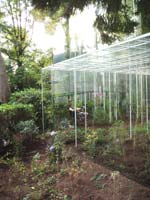 Terri Peters Architect Junya Ishigami’s delicate hand drawn landscapes adorn the bare walls and 1:1 greenhouses make this one of the most impressive pavilions of this year’s show 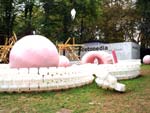 Terri Peters Denmark hosts the UN’s Climate Change conference in 2009; their pavilion “Ectopedia: Walk the Talk” looks at the future of urban living 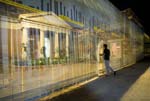 Ryan Reitbauer/Duggall U.S. Pavilion: “Into the Open: Positioning Practice” 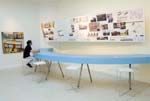 Ryan Reitbauer/Duggall U.S. Pavilion: new digital technologies, computer renderings, and theoretical musings, the pavilion had a real message about experimentation in a larger sense 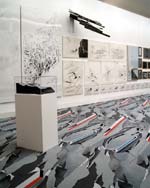 Terri Peters Italy Pavilion: A room devoted to Zaha Hadid’s striking graphics and models – even the printed carpet 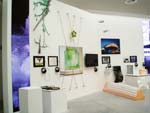 Terri Peters Italy Pavilion: Science + Fiction installation by Cloud 9  Terri Peters A big hit at the pre-opening weekend, this little red caravan served Norwegian beer, in front of the permanent Norway pavilion. 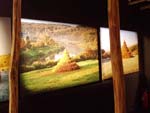 Terri Peters Utopian Russian landscapes in the downstairs pavilion paired with “Chess Play” upstairs that invites discussion about the future of Russia’s architecture 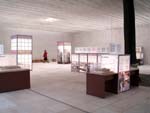 Terri Peters My favourite building in the Giardini is the striking Nordic Pavilion built by Sverre Fehn 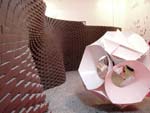 Terri Peters Switzerland: The curved brick wall built by a robot builder is a research project with ETH Zurich and Reto Geiser 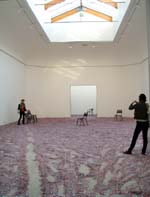 Terri Peters Belgium after the party: its almost refreshing (although bizarre) to see a pavilion emptied out and filled with confetti – but does this really represent contemporary architectural thinking in Belgium? 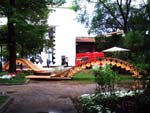 Terri Peters View towards the Italy pavilion in the Giardini; Taiwan’s glowing “jello bridges” were climbable, modular extracts from their larger interbreeding field installation |
© 2008 ArchNewsNow.com